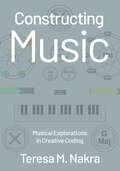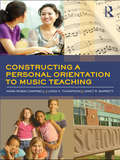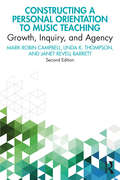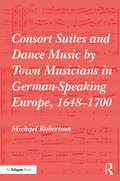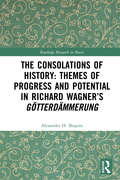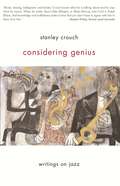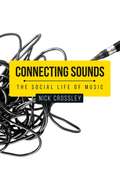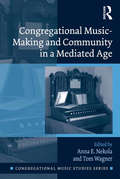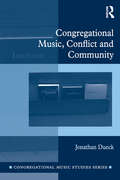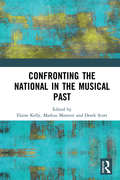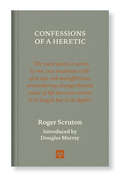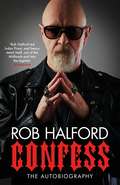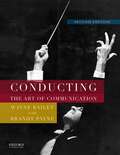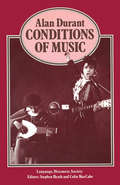- Table View
- List View
Constructing Music: Musical Explorations in Creative Coding
by Teresa M. NakraWhy does music exert such a strong pull on us? How does it work? Traditional courses in music fundamentals give students a basic understanding of the building blocks of music and how to put them together to make a result that produces an intended effect. Constructing Music: Musical Explorations in Creative Coding takes students a step further: through a series of step-by-step tutorials and lessons, author Teresa M. Nakra presents a new method for teaching music fundamentals that foregrounds creative coding practices and builds upon the computing skills that today's students already possess. By encouraging experimentation with computer code, this book gives students tools to actively investigate, simulate, and engage with the structure of music, ultimately leading to greater understanding about the processes that underlie music's power over us. Designed to support computer-based learning in tonal harmony, musicianship, and music theory, Constructing Music avoids the lens of Western music notation and instead explains music content through analogies with toy bricks and references ideas from creative technology, engineering, and design. Students also engage directly with the components of musical structure using editable short code "patches" developed in Max, a visual coding environment for interactive music, audio, and media. Dozens of patches accompany the book and allow readers to play with the building blocks of sound, reinforcing each topic by tinkering, modifying, and creating their own versions of the material. Each chapter explains core music theory concepts in detail and supports every description through code simulations, progressing through the topics with increasing complexity. In the final chapter, Nakra explores the questions and theories that emerge from the lessons, considering the role of music as a proto-form of AI and its impacts on emotion, wellness, and creativity.
Constructing a Personal Orientation to Music Teaching
by Mark Robin Campbell Linda K Thompson Janet R. BarrettConstructing a Personal Orientation to Music Teaching promotes inquiry and reflection to facilitate teacher growth, lifelong learning and a disposition toward educational change. Strongly grounded in current theories and research in teacher education, the text engages readers in analyzing their own experiences in order to conceptualize the complexity of teaching; involves them in clarifying their reasons for seeking a career in teaching; supports their insights, questions, and reflections about their work; and promotes a reflective, critical attitude about schools in general as teachers are urged to think of themselves as change agents in school settings.
Constructing a Personal Orientation to Music Teaching
by Mark Robin Campbell Linda K Thompson Janet R. BarrettConstructing a Personal Orientation to Music Teaching promotes inquiry and reflection to facilitate teacher growth, lifelong learning and a disposition toward educational change. Strongly grounded in current theories and research in teacher education, the text engages readers in analyzing their own experiences in order to conceptualize the complexity of teaching; involves them in clarifying their reasons for seeking a career in teaching; supports their insights, questions, and reflections about their work; and promotes a reflective, critical attitude about schools in general as teachers are urged to think of themselves as change agents in school settings.
Constructing a Personal Orientation to Music Teaching: Growth, Inquiry, and Agency
by Mark Robin Campbell Linda K. Thompson Janet Revell BarrettConstructing a Personal Orientation to Music Teaching: Growth, Inquiry, and Agency, (Second Edition), is a textbook for studies in music education. Expanding upon the first edition, the authors promote inquiry and reflection to facilitate teacher growth, lifelong learning, and a disposition toward educational change. The revised text responds to current calls for social change and teacher education reform by reaffirming and intensifying the need for music teachers to adopt a personal orientation toward their work. A personal orientation encourages teachers to initiate their own growth, engage in inquiry, and exercise agency in school contexts. Strongly grounded in current theories and research in teacher education, Constructing a Personal Orientation to Music Teaching: Growth, Inquiry, and Agency strives to do the following: Engage readers in analyzing their own experiences in order to conceptualize the complexity of teaching Involve them in clarifying their reasons for seeking a career in teaching Support their insights, questions, and reflections about their work Promote a reflective, critical attitude about schools in general as music teachers are urged to think of themselves as change agents in school settings Construct a moral purpose as a compass to guide their current and future endeavors in the profession. Every chapter includes a wealth of pedagogical features, including new methodologies and examples of practice to engage the readers in processes of inquiry and reflection. The second edition is organized in two parts. Part I focuses on positioning music teachers as learners in the profession, significantly expanding concepts explored in the first edition that are central to a personal orientation to professional growth. In the new edition, a reconceptualized Chapter 5 challenges teachers to cultivate their identities as change agents. The second half of the book—focusing on becoming a student of music teaching— features five new chapters. A provocative chapter on curriculum sets the stage for a set of additional chapters that invite deeper considerations of the commonplaces of teacher, learners, subject matter, and context. An epilogue speaks directly to the power of agency, imagination, and hope in teachers’ lives.
Constructing a Personal Orientation to Music Teaching: Growth, Inquiry, and Agency
by Mark Robin Campbell Linda K. Thompson Janet Revell BarrettConstructing a Personal Orientation to Music Teaching: Growth, Inquiry, and Agency, (Second Edition), is a textbook for studies in music education. Expanding upon the first edition, the authors promote inquiry and reflection to facilitate teacher growth, lifelong learning, and a disposition toward educational change. The revised text responds to current calls for social change and teacher education reform by reaffirming and intensifying the need for music teachers to adopt a personal orientation toward their work. A personal orientation encourages teachers to initiate their own growth, engage in inquiry, and exercise agency in school contexts. Strongly grounded in current theories and research in teacher education, Constructing a Personal Orientation to Music Teaching: Growth, Inquiry, and Agency strives to do the following: Engage readers in analyzing their own experiences in order to conceptualize the complexity of teaching Involve them in clarifying their reasons for seeking a career in teaching Support their insights, questions, and reflections about their work Promote a reflective, critical attitude about schools in general as music teachers are urged to think of themselves as change agents in school settings Construct a moral purpose as a compass to guide their current and future endeavors in the profession. Every chapter includes a wealth of pedagogical features, including new methodologies and examples of practice to engage the readers in processes of inquiry and reflection. The second edition is organized in two parts. Part I focuses on positioning music teachers as learners in the profession, significantly expanding concepts explored in the first edition that are central to a personal orientation to professional growth. In the new edition, a reconceptualized Chapter 5 challenges teachers to cultivate their identities as change agents. The second half of the book—focusing on becoming a student of music teaching— features five new chapters. A provocative chapter on curriculum sets the stage for a set of additional chapters that invite deeper considerations of the commonplaces of teacher, learners, subject matter, and context. An epilogue speaks directly to the power of agency, imagination, and hope in teachers’ lives.
Consort Suites and Dance Music by Town Musicians in German-Speaking Europe, 1648–1700
by Michael RobertsonThis companion volume to The Courtly Consort Suite in German-Speaking Europe surveys an area of music neglected by modern scholars: the consort suites and dance music by musicians working in the seventeenth-century German towns. Conditions of work in the German towns are examined in detail, as are the problems posed by the many untrained travelling players who were often little more than beggars. The central part of the book explores the organisation, content and assembly of town suites into carefully ordered printed collections, which refutes the concept of the so-called 'classical' suite. The differences between court and town suites are dealt with alongside the often-ignored variation suite from the later decades of the seventeenth century and the separate suite-writing traditions of Leipzig and Hamburg. While the seventeenth-century keyboard suite has received a good deal of attention from modern scholars, its often symbiotic relationship with the consort suite has been ignored. This book aims to redress the balance and to deal with one very important but often ignored aspect of seventeenth-century notation: the use of blackened notes, which are rarely notated in a meaningful way in modern editions, with important implications for performance.
Consort Suites and Dance Music by Town Musicians in German-Speaking Europe, 1648–1700
by Michael RobertsonThis companion volume to The Courtly Consort Suite in German-Speaking Europe surveys an area of music neglected by modern scholars: the consort suites and dance music by musicians working in the seventeenth-century German towns. Conditions of work in the German towns are examined in detail, as are the problems posed by the many untrained travelling players who were often little more than beggars. The central part of the book explores the organisation, content and assembly of town suites into carefully ordered printed collections, which refutes the concept of the so-called 'classical' suite. The differences between court and town suites are dealt with alongside the often-ignored variation suite from the later decades of the seventeenth century and the separate suite-writing traditions of Leipzig and Hamburg. While the seventeenth-century keyboard suite has received a good deal of attention from modern scholars, its often symbiotic relationship with the consort suite has been ignored. This book aims to redress the balance and to deal with one very important but often ignored aspect of seventeenth-century notation: the use of blackened notes, which are rarely notated in a meaningful way in modern editions, with important implications for performance.
The Consolations of History: Themes of Progress and Potential in Richard Wagner’s Gotterdammerung (Routledge Research in Music)
by Alexander H. ShapiroIn this book on Richard Wagner’s compelling but enigmatic masterpiece Götterdämmerung, the final opera of his monumental Ring tetralogy, Alexander H. Shapiro advances an ambitious new interpretation which uncovers intriguing new facets to the work’s profound insights into the human condition. By taking a fresh look at the philosophical and historical influences on Wagner, and critically reevaluating the composer’s intellectual worldview as revealed in his own prose works, letters, and diary entries, the book challenges a number of conventional views that continue to impede a clear understanding of this work’s meaning. The book argues that Götterdämmerung, and hence the Ring as a whole, achieves coherence when interpreted in terms of contemporary nineteenth-century theories of progress, and, in particular, G.W.F. Hegel’s philosophies of mind and history. A central target of the book is the article of faith that has come to dominate Wagner scholarship over the years – that Wagner’s encounter in 1854 with Arthur Schopenhauer’s philosophy conclusively altered the final message of the Ring from one of historical optimism to existential pessimism. The author contends that Schopenhauer’s uncompromising denigration of the will and denial of the possibility for human progress find no place in the written text of the Ring or in a plausible reading of the final musical setting. In its place, the author discovers in the famous Immolation Scene a celebration of mankind’s inexhaustible capacity for self-improvement and progress. The author makes the further compelling case that this message of progress is communicated not through Siegfried, the traditional male hero of the drama, but through Brünnhilde, the warrior goddess who becomes a mortal woman. In her role as a battle-tested world-historical prophet she is the true revolutionary change agent of Wagner’s opera who has the strength and vision to comprehend and thereby shape human history. This highly lucid and accessible study is aimed not only at scholars and researchers in the fields of opera studies, music and philosophy, and music history, but also Wagner enthusiasts, and readers and students interested in the history and philosophy of the nineteenth century.
The Consolations of History: Themes of Progress and Potential in Richard Wagner’s Gotterdammerung (Routledge Research in Music)
by Alexander H. ShapiroIn this book on Richard Wagner’s compelling but enigmatic masterpiece Götterdämmerung, the final opera of his monumental Ring tetralogy, Alexander H. Shapiro advances an ambitious new interpretation which uncovers intriguing new facets to the work’s profound insights into the human condition. By taking a fresh look at the philosophical and historical influences on Wagner, and critically reevaluating the composer’s intellectual worldview as revealed in his own prose works, letters, and diary entries, the book challenges a number of conventional views that continue to impede a clear understanding of this work’s meaning. The book argues that Götterdämmerung, and hence the Ring as a whole, achieves coherence when interpreted in terms of contemporary nineteenth-century theories of progress, and, in particular, G.W.F. Hegel’s philosophies of mind and history. A central target of the book is the article of faith that has come to dominate Wagner scholarship over the years – that Wagner’s encounter in 1854 with Arthur Schopenhauer’s philosophy conclusively altered the final message of the Ring from one of historical optimism to existential pessimism. The author contends that Schopenhauer’s uncompromising denigration of the will and denial of the possibility for human progress find no place in the written text of the Ring or in a plausible reading of the final musical setting. In its place, the author discovers in the famous Immolation Scene a celebration of mankind’s inexhaustible capacity for self-improvement and progress. The author makes the further compelling case that this message of progress is communicated not through Siegfried, the traditional male hero of the drama, but through Brünnhilde, the warrior goddess who becomes a mortal woman. In her role as a battle-tested world-historical prophet she is the true revolutionary change agent of Wagner’s opera who has the strength and vision to comprehend and thereby shape human history. This highly lucid and accessible study is aimed not only at scholars and researchers in the fields of opera studies, music and philosophy, and music history, but also Wagner enthusiasts, and readers and students interested in the history and philosophy of the nineteenth century.
Considering Genius: Writings on Jazz
by Stanley CrouchStanley Crouch-MacArthur "Genius” Award recipient, co-founder of Jazz at Lincoln Center, National Book Award nominee, and perennial bull in the china shop of black intelligentsia-has been writing about jazz and jazz artists for more than thirty years. His reputation for controversy is exceeded only by a universal respect for his intellect and passion. As Gary Giddons notes: "Stanley may be the only jazz writer out there with the kind of rhinoceros hide necessary to provoke and outrage and then withstand the fulminations that come back.” In Considering Genius, Crouch collects some of his best loved, most influential, and most controversial pieces (published in Jazz Times, The New Yorker, the Village Voice, and elsewhere), together with two new essays. The pieces range from the introspective "Jazz Criticism and Its Effect on the Art Form” to a rollicking debate with Amiri Baraka, to vivid, intimate portraits of the legendary performers Crouch has known.
Connecting sounds: The social life of music (G - Reference, Information And Interdisciplinary Subjects Ser.)
by Nick CrossleyCrossley argues that music is a form of social interaction, interwoven in the fabric of society and in constant interplay with its other threads. Musical interactions are often also economic interactions, for example, and sometimes political interactions. They can be forms of identity work, for both individuals and collectives, contributing to the reproduction or bridging of social divisions. Successive chapters of the book track and explore these interplays, in each case combining a critical consideration of existing literature with the development of an original, ‘relational’ approach to music sociology. The result is a grand sociological vision of music which captures not only music’s context but ‘the music itself’. The book will appeal to social scientists, musicologists and cultural scholars more widely.
Connecting sounds: The social life of music (G - Reference, Information And Interdisciplinary Subjects Ser.)
by Nick CrossleyCrossley argues that music is a form of social interaction, interwoven in the fabric of society and in constant interplay with its other threads. Musical interactions are often also economic interactions, for example, and sometimes political interactions. They can be forms of identity work, for both individuals and collectives, contributing to the reproduction or bridging of social divisions. Successive chapters of the book track and explore these interplays, in each case combining a critical consideration of existing literature with the development of an original, ‘relational’ approach to music sociology. The result is a grand sociological vision of music which captures not only music’s context but ‘the music itself’. The book will appeal to social scientists, musicologists and cultural scholars more widely.
Congregational Music-Making and Community in a Mediated Age (Congregational Music Studies Series)
by Anna E. Nekola Tom WagnerCongregational music can be an act of praise, a vehicle for theology, an action of embodied community, as well as a means to a divine encounter. This multidisciplinary anthology approaches congregational music as media in the widest sense - as a multivalent communication action with technological, commercial, political, ideological and theological implications, where processes of mediated communication produce shared worlds and beliefs. Bringing together a range of voices, promoting dialogue across a range of disciplines, each author approaches the topic of congregational music from his or her own perspective, facilitating cross-disciplinary connections while also showcasing a diversity of outlooks on the roles that music and media play in Christian experience. The authors break important new ground in understanding the ways that music, media and religious belief and praxis become ’lived theology’ in our media age, revealing the rich and diverse ways that people are living, experiencing and negotiating faith and community through music.
Congregational Music-Making and Community in a Mediated Age: Singing A New Song (Congregational Music Studies Series)
by Anna Nekola Tom WagnerCongregational music can be an act of praise, a vehicle for theology, an action of embodied community, as well as a means to a divine encounter. This multidisciplinary anthology approaches congregational music as media in the widest sense - as a multivalent communication action with technological, commercial, political, ideological and theological implications, where processes of mediated communication produce shared worlds and beliefs. Bringing together a range of voices, promoting dialogue across a range of disciplines, each author approaches the topic of congregational music from his or her own perspective, facilitating cross-disciplinary connections while also showcasing a diversity of outlooks on the roles that music and media play in Christian experience. The authors break important new ground in understanding the ways that music, media and religious belief and praxis become ’lived theology’ in our media age, revealing the rich and diverse ways that people are living, experiencing and negotiating faith and community through music.
Congregational Music, Conflict and Community (Congregational Music Studies Series)
by Jonathan DueckCongregational Music, Conflict and Community is the first study of the music of the contemporary 'worship wars' – conflicts over church music that continue to animate and divide Protestants today – to be based on long-term in-person observation and interviews. It tells the story of the musical lives of three Canadian Mennonite congregations, who sang together despite their musical differences at the height of these debates in the late 1990s and early 2000s. Mennonites are among the most music-centered Christian groups in North America, and each congregation felt deeply about the music they chose as their own. The congregations studied span the spectrum from traditional to blended to contemporary worship styles, and from evangelical to liberal Protestant theologies. At their core, the book argues, worship wars are not fought in order to please congregants' musical tastes nor to satisfy the theological principles held by a denomination. Instead, the relationships and meanings shaped through individuals’ experiences singing in the particular ways afforded by each style of worship are most profoundly at stake in the worship wars. As such, this book will be of keen interest to scholars working across the fields of religious studies and ethnomusicology.
Congregational Music, Conflict and Community (Congregational Music Studies Series)
by Jonathan DueckCongregational Music, Conflict and Community is the first study of the music of the contemporary 'worship wars' – conflicts over church music that continue to animate and divide Protestants today – to be based on long-term in-person observation and interviews. It tells the story of the musical lives of three Canadian Mennonite congregations, who sang together despite their musical differences at the height of these debates in the late 1990s and early 2000s. Mennonites are among the most music-centered Christian groups in North America, and each congregation felt deeply about the music they chose as their own. The congregations studied span the spectrum from traditional to blended to contemporary worship styles, and from evangelical to liberal Protestant theologies. At their core, the book argues, worship wars are not fought in order to please congregants' musical tastes nor to satisfy the theological principles held by a denomination. Instead, the relationships and meanings shaped through individuals’ experiences singing in the particular ways afforded by each style of worship are most profoundly at stake in the worship wars. As such, this book will be of keen interest to scholars working across the fields of religious studies and ethnomusicology.
Congas (UEB uncontracted)
by RnibThis is an image of a pair of congas (cuban drums) seen from the side. There is a locator dot shown which will be at the top left of the page when the image is the correct way up. The conga, called a tumbadora in Spanish, is a tall, narrow, single-headed Cuban drum thought to have originated in central Africa.There is a drum on the left of the page and a slightly smaller one on the right. Between the two drums is a stand going down to the bottom of the page. Only two of its three legs can be found.The drums heads are at the top of the page. Down the page are the tension rings, and the screws for adjusting tension of the drum skins. The drums are circular in cross section and open at the bottom; this cannot be seen as they are viewed from the side. They are played by hitting the skins at the top of page, with the hands and fingers. The smaller drum on the right has a higher note when struck.
Congas (UEB contracted)
by RnibThis is an image of a pair of congas (cuban drums) seen from the side. There is a locator dot shown which will be at the top left of the page when the image is the correct way up. The conga, called a tumbadora in Spanish, is a tall, narrow, single-headed Cuban drum thought to have originated in central Africa.There is a drum on the left of the page and a slightly smaller one on the right. Between the two drums is a stand going down to the bottom of the page. Only two of its three legs can be found.The drums heads are at the top of the page. Down the page are the tension rings, and the screws for adjusting tension of the drum skins. The drums are circular in cross section and open at the bottom; this cannot be seen as they are viewed from the side. They are played by hitting the skins at the top of page, with the hands and fingers. The smaller drum on the right has a higher note when struck.
Congas (large print)
by RnibThis is an image of a pair of congas (cuban drums) seen from the side. There is a locator dot shown which will be at the top left of the page when the image is the correct way up. The conga, called a tumbadora in Spanish, is a tall, narrow, single-headed Cuban drum thought to have originated in central Africa.There is a drum on the left of the page and a slightly smaller one on the right. Between the two drums is a stand going down to the bottom of the page. Only two of its three legs can be found.The drums heads are at the top of the page. Down the page are the tension rings, and the screws for adjusting tension of the drum skins. The drums are circular in cross section and open at the bottom; this cannot be seen as they are viewed from the side. They are played by hitting the skins at the top of page, with the hands and fingers. The smaller drum on the right has a higher note when struck.
Confronting the National in the Musical Past
by Elaine Kelly Markus Mantere Derek ScottThis significant volume moves music-historical research in the direction of deconstructing the national grand narratives in music history, of challenging the national paradigm in methodology, and thinking anew about cultural traffic, cultural transfer and cosmopolitanism in the musical past. The chapters of this book confront, or subject to some kind of critique, assumptions about the importance of the national in the musical past. The emphasis, therefore, is not so much on how national culture has been constructed, or how national cultural institutions have influenced musical production, but, rather, on the way the national has been challenged by musical practices or audience reception.
Confronting the National in the Musical Past
by Elaine Kelly Markus Mantere Derek B. ScottThis significant volume moves music-historical research in the direction of deconstructing the national grand narratives in music history, of challenging the national paradigm in methodology, and thinking anew about cultural traffic, cultural transfer and cosmopolitanism in the musical past. The chapters of this book confront, or subject to some kind of critique, assumptions about the importance of the national in the musical past. The emphasis, therefore, is not so much on how national culture has been constructed, or how national cultural institutions have influenced musical production, but, rather, on the way the national has been challenged by musical practices or audience reception.
CONFESSIONS OF A HERETIC: Revised Edition
by Roger ScrutonA collection of provacative essays by the late philosopher and political thinker Roger Scruton. Each 'confession' reveals aspects of the author's thinking that his critics would probably have advised him to keep to himself. Scruton sought to answer the most pressing problems of our age: what can we do to protect Western values against Islamic extremism? Why is the Nation State worth preserving? How should we achieve a timely death against the advances of modern medicine? As Douglas Murray writes in his introduction, Scruton was an outsider, yet he showed his readers 'not just what they should reject, but what they should nurture and love.' This selection offers consolation and guidance to a new generation of readers.
Confess: 'Rob Halford led Judas Priest, and heavy metal itself, out of the Midlands and into the bigtime' The Guardian
by Rob HalfordMost priests take confessions. This one is giving his.Rob Halford, front man of global iconic metal band Judas Priest, is a true 'Metal God'. Raised in Britain's hard-working heavy industrial heartland he and his music were forged in the Black Country. CONFESS, his full autobiography, is an unforgettable rock 'n' roll story - a journey from a Walsall council estate to musical fame via alcoholism, addiction, police cells, ill-starred sexual trysts and bleak personal tragedy, through to rehab, coming out, redemption... and finding love.Now, he is telling his gospel truth.Told with Halford's trademark self-deprecating, deadpan Black Country humour, CONFESS is the story of an extraordinary five decades in the music industry. It is also the tale of unlikely encounters with everybody from Superman to Andy Warhol, Madonna, Jack Nicholson and the Queen. More than anything else, it's a celebration of the fire and power of heavy metal. Rob Halford has decided to Confess. Because it's good for the soul.
